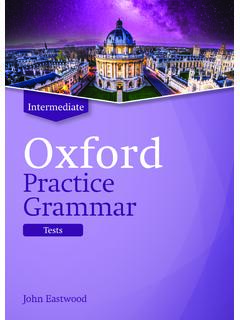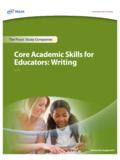Transcription of Goals and Objectives Bank
1 Goals and Objectives Bank Basic Reading Reading Comprehension Math Calculations Math Reasoning Oral Expression Listening Comprehension Written Expression Speech/Language Behavior/Social Skills Extended Standards/ Life Skills Functional Academics Adaptive PE. Occupational Therapy Physical Therapy Basic Reading (Back). K-3 4-6 7-8 9-12. K-3 Visual Memory and Discrimination When presented with objects and pictures, STUDENT will match by color, shape, or design with 90% accuracy 4 of 5 trials. When presented with letters, numbers, or words, STUDENT will match with 90%. accuracy 4 of 5 trials.
2 When using colored pegs and a pegboard, STUDENT will copy patterns from a visual model with 80% accuracy 4 of 5 trials. When using a flannel board or magnetic letters, STUDENT will copy letters from a visual model with 90% accuracy 4 of 5 trials. When using a flannel board or magnetic letters, STUDENT will copy words from a visual model with 90% accuracy 4 of 5 trials. With pencil and paper, STUDENT will copy patterns of shapes independently from a visual model with 90% accuracy 4 of 5 trials. With pencil and paper, STUDENT will copy letters independently from a visual model with 90% accuracy 4 of 5 trials.
3 With pencil and paper, STUDENT will copy words independently from a visual model with 90% accuracy 4 of 5 trials. When presented with hidden picture puzzles and Find Waldo activities, STUDENT will search and point out certain objects within the design with 100% accuracy 4 of 5. trials. After looking at a picture or photo for one minute, STUDENT will be able to recall details with 80% accuracy 4 of 5 trials. When presented with upper and lower case letters, STUDENT will be able to distinguish the difference between the letters with 90% accuracy 4 of 5 trials. When presented with short sentences with familiar words, STUDENT will match the outlined configurations of individual words with words in a sentence with 80%.
4 Accuracy 4 of 5 trials. When presented with word cards, STUDENT will alphabetize the words by the first letter with 80% accuracy 4 of 5 trials. When presented with word cards, STUDENT will alphabetize the words using the second letter with 80% accuracy 4 of 5 trials. When given word cards, STUDENT will recognize word endings that show: more than one (s, es); past tense (ed); ownership ( s, s'); and contractions with 80%. accuracy 4 of 5 trials. While using word cards, STUDENT will combine words to form compound words with 80% accuracy 4 of 5 trials. While reading sentences, STUDENT will use context clues to analyze new words and then read the sentence using the correct pronunciation of the new words with 80%.
5 Accuracy 4 of 5 trials. When given a series of words, STUDENT will correctly identify the root word with 80%. accuracy 4 of 5 trials. When given commonly used sight words, STUDENT will accurately read with 98%. accuracy 3 of 4 trials. While using word cards, STUDENT will describe the difference between homophone pairs (ex. new/knew, hear/hear, and their/there/they're) with 80% accuracy 4 of 5 trials. While reading a passage orally, STUDENT will demonstrate self-correcting of errors by pausing in the text, using context clues and phonetic skills, and then rereading the phrase for meaning 90% accuracy 4 of 5 trials.
6 While reading orally, STUDENT will demonstrate reading fluency by making no more than 2 errors in a one hundred word passage at instructional level 4 of 5 trials. While reading a short play, STUDENT will read aloud using tone/inflection appropriate to the reading material with 90% accuracy 4 of 5 trials. K-3 Phonics and Word Recognition Skills (Back). When asked, STUDENT will name all upper and lower case letters and identifies the representative sounds with 80% accuracy four of five trials. When presented with a, e, i, o, u, and y, STUDENT will distinguish long and short vowel sounds with 80% accuracy in four of five trials.
7 When presented with single syllable words, STUDENT will distinguish the initial and final sounds with 80% accuracy in four of five trials. When reading a story or poem, STUDENT will identify rhyming words when asked with 80% accuracy in two of three trials. While reading at instructional level, STUDENT will blend beginning, middle, and ending sounds to form words with 80% accuracy in five consecutive sessions. While reading a passage, STUDENT will use knowledge of consonants, consonant blends, and common vowel patterns to decode unfamiliar words with 90% accuracy in three trials. When presented with printed text, STUDENT will identify common contractions, compound words, and abbreviations with 80 % accuracy four of five trials.
8 While reading a passage, STUDENT will use decoding and word recognition skills with 80% accuracy four of five trials. When asked, STUDENT will read a 100 word story at instructional level making no more than 8 oral reading errors and will answer 3 of 5 comprehension questions correctly 3 consecutive days. When shown a list of 30 blend-vowel and digraph-vowel combinations, STUDENT. will give the correct sound of the initial blend or digraph at 100% accuracy 5 consecutive days. Given a passage at instructional level, STUDENT will read a 100 word passage in less than 2 minutes making no more than 12 oral reading errors for 5 consecutive sessions.
9 Given the basic sight words, STUDENT will read 100 sight words with 100% accuracy on 5 consecutive trials. Given a list of vocabulary words, STUDENT will read the words correctly with 90%. accuracy in 3/4 trials. K-3 Auditory Discrimination (Back). When presented with a tape of sounds (music sounds, animals sounds, and environmental sounds), STUDENT will identify the common sounds with 80%. accuracy 4 of 5 trials. With HIS back to the teacher and after listening to a pattern of sounds made by the teacher with sound-producing instruments, STUDENT will turn to face the teacher and duplicate the pattern heard with 80% accuracy 8 of 10 trials.
10 After listening to the teacher read a series of words beginning with the same consonant, STUDENT wills either supply the name of the letter heard or choose the correct letter from two letter cards with 90% accuracy 8 of 10 trials. When presented with word and picture cards, STUDENT recognize and discriminate the final sounds of n, d, k, m, t, and p with 90% accuracy 4 of 5 trials. After being presented with a very short story or sets of sentences that include words with one or two target ending sounds, STUDENT will circle words ending with the same sound with 80% accuracy 4 of 5 trials.


